Der Westwall (English: The West Wall) is a 1939 film about the Siegfried Line directed by Fritz Hippler, the head of the film division within the Propagandaministerium. The Siegfried Line, called the West Wall by the Germans, was a large series of fortifications around the German borders with France, Belgium, Luxembourg, and the Netherlands.

The Siegfried Line, known in German as the Westwall, was a German defensive line built during the 1930s opposite the French Maginot Line. It stretched more than 630 km (390 mi); from Kleve on the border with the Netherlands, along the western border of Nazi Germany, to the town of Weil am Rhein on the border with Switzerland – and featured more than 18,000 bunkers, tunnels and tank traps.

Virus West is German black metal band Nagelfar's third and last album before they broke up. The album was recorded in June 2000 in Andy Classen's Stage-One-Studio. The track "Hellebarn" contains a sample from the 1982 film The Thing.

Ochtrup is a town in the district of Steinfurt, in North Rhine-Westphalia, Germany. It is situated approximately 20 km west of Rheine and 20 km east of Enschede.
A main line of resistance (MLR) is the most important defensive position of an army facing an opposing force over an extended front. It does not consist of one trench or line of pillboxes, but rather a system, of varying degrees of complexity, of fighting positions and obstacles to slow enemy advances.

The West Wall Medal was a decoration of Nazi Germany. It was instituted on 2 August 1939 and was given to those who designed and built the fortifications on Germany's western borders, known as the Westwall or, in English, the Siegfried Line, between 15 June 1938 to 31 March 1939. On 13 November 1939 eligibility was extended to include servicemen of the Wehrmacht who served on the Westwall for at least ten weeks. In all 622,064 medals were awarded until 31 January 1941, when awards of the medal ceased.
Siegfried is a masculine German given name.
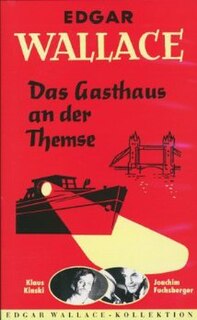
The Inn on the River is a 1962 West German crime film directed by Alfred Vohrer and starring Joachim Fuchsberger, Eddi Arent and Klaus Kinski. It is part of a cycle of films based on the novels of Edgar Wallace, produced in West Germany in the 1950s and 1960s.
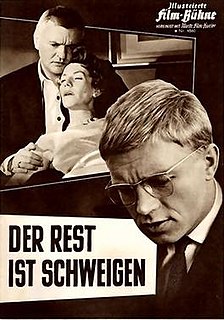
The Rest Is Silence is a 1959 West German crime film directed by Helmut Käutner. It was entered into the 9th Berlin International Film Festival.
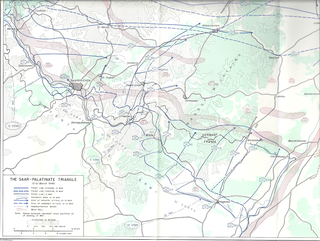
Operation Undertone, also known as the Saar-Palatinate Offensive, was a large assault by the U.S. Seventh, Third, and French First Armies of the U.S. Sixth and Twelfth Army Groups as part of the Allied invasion of Germany in March 1945 during World War II.
The Western Wall is a sacred Jewish pilgrimage site in Jerusalem.
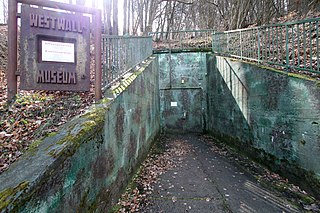
The Siegfried Line Museum at Pirmasens is a museum in the German state of Rhineland-Palatinate that is housed in a former subterranean fortification on the edge of the village of Niedersimten in southwest Palatinate (region). Its theme is war, but it also views itself as a memorial to peace. It was founded by the Gerstfeldhöhe Society and is run in cooperation with the town of Pirmasens.

The Regelbau were a series of standardised bunker designs built in large numbers by the Germans in the Siegfried Line and the Atlantic Wall as part of their defensive fortifications prior to and during the Second World War.
The Orscholz Switch, or Siegfried Switch, was a military defensive "switch" position and part of the Siegfried Line (Westwall) located in the triangle between the rivers Saar and Moselle. It was built in 1939 and 1940 and incorporated 75 bunkers as well as 10.2 km of tank obstacles in the form of dragon's teeth. This defensive line ran from Trier to Nennig along the Moselle and from Nennig in an easterly direction to Orscholz on the loop in the Saar river at Mettlach.
Although the West Wall in this sector lay behind the Saar, the Germans in 1939 and 1940 had constructed a supplementary fortified line across the base of the triangle from Nennig in the west to Orscholz, at a great northwestward loop of the Saar. The Germans called the position the Orscholz Switch; the Americans knew it as the Siegfried Switch. Assuming the neutrality of Luxembourg, the switch position was designed to protect Trier and the Moselle corridor and to prevent outflanking of the strongest portion of the West Wall, that lying to the southeast across the face of the Saar industrial area.

The Forger of London is a 1961 West German crime film directed by Harald Reinl and starring Karin Dor, Hellmut Lange and Siegfried Lowitz. It is an adaptation of Edgar Wallace's 1927 novel The Forger, and part of a long-running series of German Wallace films made during the decade.
The Siegfried Line Museum lies near the German-Luxembourg border in the Eifel mountains. It is housed in a bunker that was part of the former Siegfried Line (Westwall), the Katzenkopf Strongpoint, which was built from 1937 to 1939. The bunker and museum lies within the municipality of Irrel and have been open to visitors since 1979. Together with other bunkers the Panzerwerk Katzenkopf was built to guard the main road from Cologne to the city of Luxembourg. It is the northernmost strongpoint in the Siegfried Line.
Der Hexer is a 1964 West German black and white mystery film directed by Alfred Vohrer and starring Joachim Fuchsberger. It was part of a very successful series of German films based on the writings of Edgar Wallace and adapted from the 1925 novel titled The Ringer. In 1965, a sequel Neues vom Hexer was released.

The Sinister Monk is a 1965 West German thriller film directed by Harald Reinl and starring Karin Dor, Harald Leipnitz and Siegfried Lowitz. It is based on the 1927 play The Terror by Edgar Wallace and was part of a very successful series of German films inspired by his works.
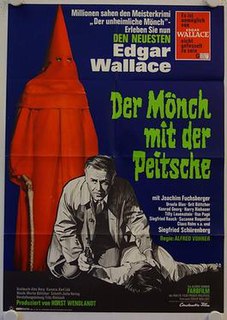
The Monk with the Whip is a 1967 West German mystery thriller film directed by Alfred Vohrer and starring Joachim Fuchsberger, Uschi Glas and Grit Boettcher. It is inspired by the 1926 novel The Black Abbot and subsequent 1927 play The Terror by Edgar Wallace which also served as the basis for the 1965 film The Sinister Monk. It was made as part of a long-running series of film adaptations of his work produced by Rialto Film.
The 555th Infantry Division was an infantry division of the German Heer during World War II.